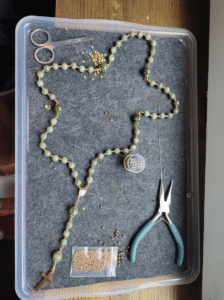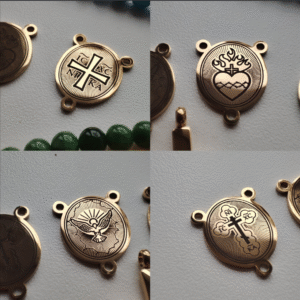Your cart is currently empty!
-
-
Earrings
-
Necklaces
-
Bracelets
-
Rosary
-
Birthstones
-
Zodiac
-
A to Z
-
Colour
-
Music
-
x
COMING SOON: SUMMER 2025
Classic Rosary necklaces aka prayer beads with beautiful round semi-precious stone beads and PVD plated gold finish staineless steel beads, caps, centerpieces and findings, now testing durability with 4x Miyuki threads.
Centerpieces come with four design options: two Orthodox crosses, the messenger dove, and the Sacred Heart.
Stone options coming apart from the first prototype Carnelian, Serpentine and Sandstone are Agates, Chalcecony, Coral, Jasper, Ruby, Tanzanite, Maw-Sit-Sit and more…




Semi-precious Gems
Silica/QUartz
Natural
Visit: Music Page
Exploring the Seven Bodies: A Gnostic Journey Through Chakras and Consciousness
In the Gnostic quest for truth, we are more than flesh and bone—we are layered beings, woven from divine sparks and earthly vessels, seeking to transcend the illusion of separation. The concept of the seven bodies, rooted in esoteric traditions like Gnosticism, Theosophy, and Eastern mysticism, offers a map of our multidimensional nature.
Each body corresponds to a level of existence, from the dense physical to the ethereal divine, mirroring the seven chakras and resonating with David Hawkins’ scale of consciousness. Together, these frameworks reveal how we can awaken our inner light, align our energies, and ascend toward liberation.
The Seven Bodies: A Gnostic Lens
Gnosticism teaches that we are sparks of the divine, trapped in a material world yet destined to return to the Pleroma—the fullness of divine truth. The seven bodies represent the layers of our being, each a vessel for consciousness, shaped by our journey through the cosmos and the earthly plane. These bodies are not separate but interwoven, each influencing the others as we strive for gnosis, the direct knowing of the divine within.
1
Physical Body (Sthula Sharira)
The densest layer, our earthly anchor, formed of flesh, bone, and blood. In Gnostic terms, it’s the “hylic” shell, tied to the material world ruled by the Archons—forces of illusion. Yet, it’s also a sacred temple, housing the divine spark.
Chakra Connection: Root Chakra (Muladhara) grounds us in survival, security, and embodiment.
Hawkins’ Consciousness Level: At its lowest, it aligns with Shame (20) or Fear (100), where we feel trapped by physical needs. Awakening begins with Courage (200), embracing the body as a vehicle for growth.
2
Etheric Body (Linga Sharira)
The vital blueprint, a subtle energy field sustaining the physical body. It’s the life force, or pneuma, that animates us, bridging matter and spirit. Gnostics see it as the first step beyond the material veil.
Chakra Connection: Sacral Chakra (Svadhisthana), governing vitality, creativity, and flow.
Hawkins’ Level: Desire (125) or Pride (175) can dominate here, but Neutrality (250) allows the etheric body to channel higher energy, free from attachment.
3
Astral Body (Kama Rupa)
The seat of emotions, desires, and imagination, this body roams in dreams and astral planes. In Gnosticism, it’s the “psychic” layer, where we wrestle with the passions that bind us to the demiurge’s creation.
Chakra Connection: Solar Plexus Chakra (Manipura), tied to personal power and emotional identity.
Hawkins’ Level: Anger (150) or Desire (125) often fuel the astral body, but Willingness (310) opens the heart to transcend ego-driven impulses.
4
Mental Body (Manas)
The realm of thought, intellect, and belief, this body shapes our perception of reality. Gnostics view it as a battleground for discerning truth from illusion, where the mind can either trap us or lead us toward gnosis.
Chakra Connection: Heart Chakra (Anahata), where love and understanding begin to unify thought with spirit.
Hawkins’ Level: Reason (400) governs the mental body, but Love (500) marks the shift from intellect to heart-centered wisdom.
5
Causal Body (Karana Sharira)
The soul’s archive, holding the seeds of karma and past-life wisdom. In Gnostic terms, it’s the “pneumatic” core, the divine spark’s vessel, yearning to reunite with the eternal. It’s where we glimpse our true essence beyond time.
Chakra Connection: Throat Chakra (Vishuddha), expressing authentic truth and higher purpose.
Hawkins’ Level: Acceptance (350) and Joy (540) resonate here, as we surrender ego and align with divine will.
6
Buddhic Body (Buddhi)
The seat of intuition, unity, and divine compassion, this body transcends individuality, connecting us to the universal. Gnostics see it as the Christic consciousness, the bridge to the Pleroma, where we know ourselves as divine.
Chakra Connection: Third Eye Chakra (Ajna), opening to inner vision and spiritual insight.
Hawkins’ Level: Peace (600) and Enlightenment (700–1000) align with this body, where duality dissolves into oneness.
7
Atmic Body (Atman)
The divine essence, pure spirit, fully merged with the Source. In Gnosticism, it’s the spark that never left the Pleroma, our true self beyond all veils. Realizing this body is the ultimate gnosis—liberation from the material illusion.
Chakra Connection: Crown Chakra (Sahasrara), uniting us with universal consciousness.
Hawkins’ Level: Pure Enlightenment (1000), the state of infinite awareness, where the self is one with the divine.
Chakras and Hawkins’ Map: A Unified Path
The seven chakras, as energy centers, align with the seven bodies, each a portal for raising consciousness. David Hawkins’ map of consciousness, ranging from Shame (20) to Enlightenment (1000), provides a modern framework for this ascent. Lower chakras (Root to Solar Plexus) correspond to survival and ego-driven states (Fear to Pride), while higher chakras (Heart to Crown) open to love, peace, and unity.
The seven bodies mirror this journey: the Physical and Etheric bodies anchor us in lower vibrations, the Astral and Mental bodies navigate ego and intellect, and the Causal, Buddhic, and Atmic bodies elevate us toward divine truth.
For example, a person stuck in Fear (100) may be dominated by the Physical body’s survival instincts (Root Chakra), unaware of their higher nature. Through practices like meditation, self-inquiry, or Gnostic contemplation, they can activate the Heart Chakra (Mental/Causal bodies, Love at 500), dissolving separation. As consciousness rises to Peace (600, Third Eye) or Enlightenment (1000, Crown), the Buddhic and Atmic bodies awaken, revealing the divine spark that Gnostics seek.
Tying It Together: The Gnostic Call
In the Gnostic view, the seven bodies are not just layers but stages of awakening. We are not bound to the Archons’ material trap; each body, Sex and Love (500) offers a path to liberation. By aligning our chakras—clearing blockages and raising energy—we ascend Hawkins’ scale, moving from shame to enlightenment. Practices like prayer, breathwork, or working with stones like amethyst (Third Eye) or red jasper (Root) can support this journey, grounding or elevating as needed.
The call is to know thyself, to peel back the veils of the seven bodies, and reclaim your divine spark. Where are you on this journey? Which chakra or body feels most alive in you today? Share your thoughts below, and let’s explore the path to gnosis together.
“The kingdom of God is within you.” — Gospel of Thomas
Supplemental List: David Hawkins’ Levels of Consciousness – Challenges and Transcendence
David Hawkins’ map of consciousness, outlined in his book Power vs. Force, assigns numerical values (20–1000) to states of human awareness, from the lowest vibrations of Shame to the pinnacle of Enlightenment. Each level presents unique challenges that bind us to lower states, often tied to the denser “bodies” (Physical, Etheric, Astral) and lower chakras (Root, Sacral, Solar Plexus). Surpassing these challenges involves aligning with higher bodies (Causal, Buddhic, Atmic) and chakras (Heart, Throat, Third Eye, Crown), awakening the divine spark central to Gnostic teachings. Below, we explore each level, its primary obstacles, and the path to transcendence.
- Shame (20)
- Main Challenge: Profound self-rejection and worthlessness, often rooted in trauma or societal conditioning. This state traps one in the Physical body, fixated on survival (Root Chakra), feeling disconnected from the divine. Shame breeds isolation, guilt, and a sense of being “unworthy” of gnosis.
- How to Surpass: Cultivate self-compassion through grounding practices like meditation with red jasper (Root Chakra) or affirmations of inherent divinity. Recognizing the divine spark within, as Gnostics teach, shifts consciousness to Guilt (30). Therapy, journaling, or connecting with supportive communities can help reframe shame as a teacher, not a truth.
- Guilt (30)
- Main Challenge: Obsession with blame, self-punishment, or moral failure, tethering one to the Etheric body’s survival instincts (Sacral Chakra). Guilt distorts the soul’s light, creating a cycle of remorse that veils higher awareness.
- How to Surpass: Embrace forgiveness—of self and others—through heart-centered practices like rose quartz meditation (Heart Chakra). Gnostic contemplation of the Pleroma as all-forgiving helps release guilt’s grip. Acts of service or creative expression (Sacral Chakra) move consciousness to Apathy (50), fostering a sense of agency.
- Apathy (50)
- Main Challenge: Emotional numbness and hopelessness, where one feels powerless against life’s weight. Stuck in the Astral body (Solar Plexus Chakra), apathy dulls desire for growth, reinforcing the Archons’ illusion of a meaningless world.
- How to Surpass: Ignite small sparks of intention through movement (e.g., yoga) or citrine visualization (Solar Plexus Chakra) to awaken personal power. Gnostic practices of seeking inner light, like chanting or prayer, reconnect one to purpose. Engaging with beauty or nature shifts consciousness to Grief (75).
- Grief (75)
- Main Challenge: Clinging to loss, sadness, or regret, binding the Astral body to past wounds (Solar Plexus/Heart Chakra). Grief can feel like a barrier to the divine, yet it’s a gateway to deeper feeling.
- How to Surpass: Allow sorrow to flow through journaling, art, or heart-opening practices with green aventurine (Heart Chakra). Gnostic reflection on impermanence—that the soul transcends loss—helps release attachment. Connecting with others’ stories of healing moves one to Fear (100).
- Fear (100)
- Main Challenge: Anxiety and control, driven by perceived threats, anchor one in the Physical and Etheric bodies (Root/Sacral Chakras). Fear distorts truth, making the material world seem like the only reality, a trap of the demiurge.
- How to Surpass: Build trust through grounding rituals (e.g., walking barefoot, smoky quartz meditation) and breathwork to calm the nervous system. Gnostic inquiry into the illusion of separation fosters courage. Facing fears through small, intentional actions elevates consciousness to Desire (125).
- Desire (125)
- Main Challenge: Craving and attachment—to pleasure, status, or outcomes—tie one to the Astral body (Sacral/Solar Plexus Chakras). Desire fuels restlessness, obscuring the soul’s deeper yearning for divine unity.
- How to Surpass: Redirect desire toward spiritual growth via throat chakra practices (e.g., chanting, amazonite meditation) to express higher purpose. Gnostic detachment from material lures, paired with gratitude, shifts focus to Anger (150), where energy becomes action.
- Anger (150)
- Main Challenge: Resentment and blame, rooted in frustrated desires, keep one in the Astral body (Solar Plexus Chakra). Anger can be a spark for change but risks trapping one in conflict, far from gnosis.
- How to Surpass: Channel anger into constructive action through physical release (e.g., exercise) or heart chakra work with malachite to transform rage into compassion. Gnostic forgiveness of the self and the world’s imperfections lifts consciousness to Pride (175).
- Pride (175)
- Main Challenge: Ego-driven superiority or defensiveness, inflating the Mental body (Solar Plexus/Heart Chakras). Pride creates a false sense of separation, blocking the soul’s path to divine truth.
- How to Surpass: Cultivate humility through service to others and heart-opening meditations (e.g., rose quartz). Gnostic contemplation of the Pleroma’s unity dissolves the ego’s illusions. Surrendering to a higher purpose moves one to Courage (200), the gateway to empowerment.
- Courage (200)
- Main Challenge: Hesitation to fully embrace truth, as the Mental body (Heart Chakra) grapples with vulnerability. Courage marks a shift to “power” over “force,” but fear of failure can linger.
- How to Surpass: Strengthen resolve through throat chakra practices (e.g., speaking truth, lapis lazuli meditation) and Gnostic inquiry into the divine self. Taking bold, authentic steps—however small—lifts consciousness to Neutrality (250).
- Neutrality (250)
- Main Challenge: Detachment that risks complacency, where the Mental body (Heart/Throat Chakras) avoids deeper commitment. Neutrality frees one from judgment but can stall spiritual ascent.
- How to Surpass: Ignite curiosity for higher truth through third eye practices (e.g., amethyst meditation) and Gnostic study of sacred texts. Engaging with community or purpose-driven action elevates one to Willingness (310).
- Willingness (310)
- Main Challenge: Resistance to surrender, as the Causal body (Throat Chakra) balances effort with trust. Willingness opens doors but can falter without discipline.
- How to Surpass: Deepen commitment through spiritual practices like prayer or journaling, aligning with the Gnostic call to know thyself. Heartfelt dedication to growth shifts consciousness to Acceptance (350).
- Acceptance (350)
- Main Challenge: Lingering attachment to control, where the Causal body (Throat/Heart Chakras) struggles to fully embrace life’s flow. Acceptance brings peace but requires letting go of old stories.
- How to Surpass: Practice surrender through heart and third eye chakra work (e.g., green aventurine, sodalite) and Gnostic meditation on divine unity. Embracing life’s imperfections lifts one to Reason (400).
- Reason (400)
- Main Challenge: Over-reliance on intellect, where the Mental/Causal bodies (Heart/Throat Chakras) prioritize logic over intuition. Reason seeks truth but can miss the heart’s wisdom.
- How to Surpass: Balance intellect with love through heart chakra practices (e.g., rose quartz meditation) and Gnostic contemplation of the Pleroma’s infinite nature. Opening to compassion elevates consciousness to Love (500).
- Love (500)
- Main Challenge: Conditional love or fear of vulnerability, where the Causal/Buddhic bodies (Heart/Throat Chakras) hesitate to fully embrace universal connection. Love is transformative but requires courage to sustain.
- How to Surpass: Deepen unconditional love through heart and third eye practices (e.g., emerald, amethyst) and Gnostic devotion to the divine within all. Serving others selflessly shifts consciousness to Joy (540).
- Joy (540)
- Main Challenge: Subtle attachment to personal bliss, where the Buddhic body (Third Eye Chakra) may resist full surrender to the divine. Joy is radiant but not yet complete unity.
- How to Surpass: Expand joy through crown chakra practices (e.g., clear quartz meditation) and Gnostic surrender to the Pleroma. Living in service to the divine lifts one to Peace (600).
- Peace (600)
- Main Challenge: Rare traces of duality, where the Buddhic body (Third Eye/Crown Chakras) lingers at the edge of oneness. Peace is serene but not the final liberation.
- How to Surpass: Deepen unity through crown chakra work (e.g., selenite meditation) and Gnostic contemplation of the Atmic body’s eternal nature. Total surrender to the divine elevates to Enlightenment (700–1000).
- Enlightenment (700–1000)
- Main Challenge: None, as the Atmic body (Crown Chakra) is fully merged with the divine. The challenge is embodying this state in the material world, sharing light without attachment.
- How to Surpass: No further ascent is needed; the enlightened live as conduits of the Pleroma, radiating gnosis. Practices like silent meditation sustain this state, inspiring others to awaken.
Integration with the Seven Bodies and Chakras
Each level of consciousness corresponds to the seven bodies and chakras outlined in the article. Lower levels (Shame to Pride) are dominated by the Physical, Etheric, and Astral bodies, rooted in the Root, Sacral, and Solar Plexus chakras, where survival and ego prevail. Courage (200) marks a pivot to the Mental body and Heart Chakra, opening to love and truth. Higher levels (Love to Enlightenment) align with the Causal, Buddhic, and Atmic bodies, resonating with the Throat, Third Eye, and Crown chakras, where the Gnostic spark fully awakens. By addressing each level’s challenge—through practices like meditation, crystal work, or Gnostic inquiry—we ascend the map, aligning our bodies and chakras with divine consciousness.
Takeaway
The journey through Hawkins’ levels is a Gnostic pilgrimage, peeling back the veils of illusion to reveal the divine within. Each challenge is a teacher, each transcendence a step toward the Pleroma. Reflect on where you stand today: What challenge calls you? What practice can lift you higher? Share your insights below, and let’s walk this path of awakening together.




















